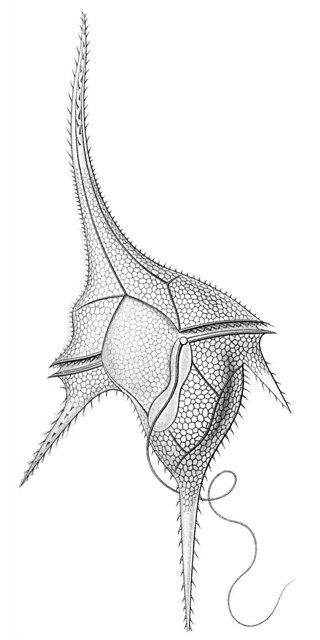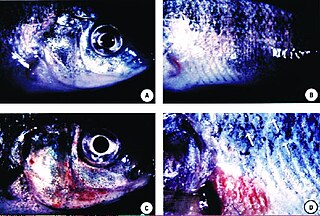
The dinoflagellates are a monophyletic group of single-celled eukaryotes constituting the phylum Dinoflagellata and are usually considered protists. Dinoflagellates are mostly marine plankton, but they also are common in freshwater habitats. Their populations vary with sea surface temperature, salinity, and depth. Many dinoflagellates are photosynthetic, but a large fraction of these are in fact mixotrophic, combining photosynthesis with ingestion of prey.

The alveolates are a group of protists, considered a major clade and superphylum within Eukarya. They are currently grouped with the stramenopiles and Rhizaria among the protists with tubulocristate mitochondria into the SAR supergroup.

Pfiesteria is a genus of heterotrophic dinoflagellates that has been associated with harmful algal blooms and fish kills. Pfiesteria complex organisms (PCOs) were claimed to be responsible for large fish kills in the 1980s and 1990s on the coast of North Carolina and in tributaries of the Chesapeake Bay. In reaction to the toxic outbreaks, six states along the US east coast have initiated a monitoring program to allow for rapid response in the case of new outbreaks and to better understand the factors involved in Pfiesteria toxicity and outbreaks. New molecular detection methods have revealed that Pfiesteria has a worldwide distribution.

Noctiluca scintillans is a marine species of dinoflagellate that can exist in a green or red form, depending on the pigmentation in its vacuoles. It can be found worldwide, but its geographical distribution varies depending on whether it is green or red. This unicellular microorganism is known for its ability to bioluminesce, giving the water a bright blue glow seen at night. However, blooms of this species can be responsible for environmental hazards, such as toxic red tides. They may also be an indicator of anthropogenic eutrophication.

Peridinin is a light-harvesting apocarotenoid, a pigment associated with chlorophyll and found in the peridinin-chlorophyll-protein (PCP) light-harvesting complex in dinoflagellates, best studied in Amphidinium carterae.

Symbiodinium is a genus of dinoflagellates that encompasses the largest and most prevalent group of endosymbiotic dinoflagellates known. These unicellular microalgae commonly reside in the endoderm of tropical cnidarians such as corals, sea anemones, and jellyfish, where the products of their photosynthetic processing are exchanged in the host for inorganic molecules. They are also harbored by various species of demosponges, flatworms, mollusks such as the giant clams, foraminifera (soritids), and some ciliates. Generally, these dinoflagellates enter the host cell through phagocytosis, persist as intracellular symbionts, reproduce, and disperse to the environment. The exception is in most mollusks, where these symbionts are intercellular. Cnidarians that are associated with Symbiodinium occur mostly in warm oligotrophic (nutrient-poor), marine environments where they are often the dominant constituents of benthic communities. These dinoflagellates are therefore among the most abundant eukaryotic microbes found in coral reef ecosystems.

Blue-sensitive opsin is a protein that in humans is encoded by the OPN1SW gene.

Predatory dinoflagellates are predatory heterotrophic or mixotrophic alveolates that derive some or most of their nutrients from digesting other organisms. About one half of dinoflagellates lack photosynthetic pigments and specialize in consuming other eukaryotic cells, and even photosynthetic forms are often predatory.

Karenia is a genus that consists of unicellular, photosynthetic, planktonic organisms found in marine environments. The genus currently consists of 12 described species. They are best known for their dense toxic algal blooms and red tides that cause considerable ecological and economical damage; some Karenia species cause severe animal mortality. One species, Karenia brevis, is known to cause respiratory distress and neurotoxic shellfish poisoning (NSP) in humans.
Amoebophyra is a genus of dinoflagellates. Amoebophyra is a syndinian parasite that infects free-living dinoflagellates that are attributed to a single species by using several host-specific parasites. It acts as "biological control agents for red tides and in defining species of Amoebophrya." Researchers have found a correlation between a large amount of host specify and the impact host parasites may have on other organisms. Due to the host specificity found in each strain of Amoebophrya's physical makeup, further studies need to be tested to determine whether the Amoebophrya can act as a control against harmful algal blooms.
Karlodinium is a genus of athecate dinoflagellates. They are often toxin producing, and compared to the other members of the Kareniaceae, are fairly small at <8-15 µm diameter.

Gonyaulax is a genus of dinoflagellates with the type species Gonyaulax spinifera Diesing. Gonyaulax belongs to red dinoflagellates and commonly causes red tides. It secretes a poisonous toxin known as "saxitoxin" which causes paralysis in humans.
Chlorophyll c refers to forms of chlorophyll found in certain marine algae, including the photosynthetic Chromista and dinoflagellates. These pigments are characterized by their unusual chemical structure, with a porphyrin as opposed to the chlorin as the core; they also do not have an isoprenoid tail. Both these features stand out from the other chlorophylls commonly found in algae and plants.
A variety of health effects can result from tattooing. Because it requires breaking the skin barrier, tattooing carries inherent health risks, including infection and allergic reactions. Modern tattooists reduce such risks by following universal precautions, working with single-use disposable needles, and sterilising equipment after each use. Many jurisdictions require tattooists to undergo periodic bloodborne pathogen training, such as is provided through the Red Cross and the U.S. Occupational Safety and Health Administration.
Dinotoxins are a group of toxins which are produced by flagellate, aquatic, unicellular protists called dinoflagellates. Dinotoxin was coined by Hardy and Wallace in 2012 as a general term for the variety of toxins produced by dinoflagellates. Dinoflagellates are an enormous group of marine life, with much diversity. With great diversity comes many different toxins, however, there are a few toxins that multiple species have in common.

An ocelloid is a subcellular structure found in the family Warnowiaceae (warnowiids), which are members of a group of unicellular organisms known as dinoflagellates. The ocelloid is analogous in structure and function to the eyes of multicellular organisms, which focus, process and detect light. The ocelloid is much more complex than the eyespot, a light-sensitive structure also found in unicellular organisms, and is in fact one of the most complex known subcellular structures. It has been described as a striking example of convergent evolution.
Karlodinium decipiens is a species of unarmored dinoflagellates from the genus Karlodinium. It was first isolated from the Australian region of the Southern Ocean, but has a widespread distribution, through the Southern Ocean to the Tasman Sea, to the coast of Spain. It is large-sized and is characterized by having a helicoidal chloroplast arrangement and a big central nucleus. It is considered potentially ichthyotoxic.

Gambierdiscus is a genus of marine dinoflagellates that produce ciguatoxins, a type of toxin that causes the foodborne illness known as ciguatera. They are usually epiphytic on macroalgae growing on coral reefs.

Dinoflagellates are eukaryotic plankton, existing in marine and freshwater environments. Previously, dinoflagellates had been grouped into two categories, phagotrophs and phototrophs. Mixotrophs, however include a combination of phagotrophy and phototrophy. Mixotrophic dinoflagellates are a sub-type of planktonic dinoflagellates and are part of the phylum Dinoflagellata. They are flagellated eukaryotes that combine photoautotrophy when light is available, and heterotrophy via phagocytosis. Dinoflagellates are one of the most diverse and numerous species of phytoplankton, second to diatoms.
Karlodinium armiger is a species of dinoflagellates belonging to the family Kareniaceae. It was first isolated from the Mediterranean sea & described in 2006.













